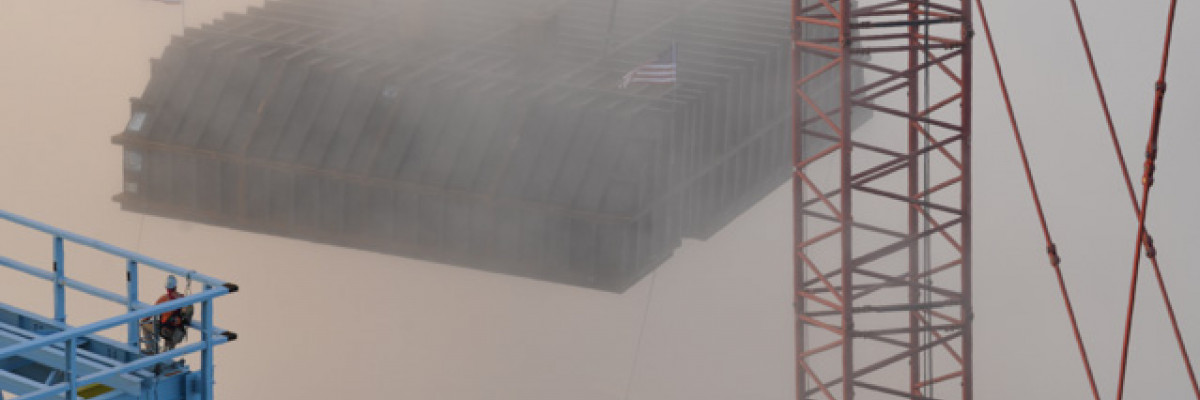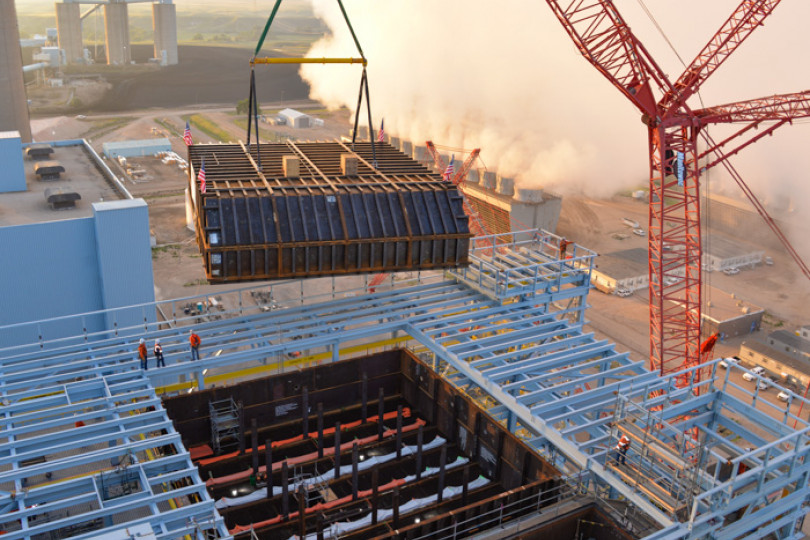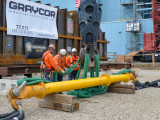“The welding…has been fantastic on this job. That speaks to the quality of craft we’ve been receiving.”
— Matt Bero, Graycor
Boilermakers side-step 70-mph wind
IN THE FOGGY pre-dawn calm at the Laramie River Station, a coal-fired power plant east of Wheatland, Wyoming, Boilermakers working for contractor Graycor hustled to lift a 176-ton SCR (selective catalytic reduction) cap and fly it to top the new unit. Eight members worked against time to place the cap and beat the gusty Wyoming wind that usually kicks up around dawn.
Ray Linzee, Graycor’s Boilermaker superintendent for the job, and also a member of Local 363 (East St. Louis, Illinois) called the wind relentless. “I’ve never experienced consistent 70-mph wind. It’s an impressive force to even walk against.”
He shook his head at the thought of a pick that size swaying in the wind during a lift. “That’s something I never want to see.”
The pick of the SCR cap in July crowned an equally successful job building the SCR unit at Laramie River Station. The plant is operated by Basin Electric for the Missouri Basin Power Project and delivers electricity across Wyoming, Nebraska and Colorado.
With Local 101 (Denver) leading the job, an average of 40 members — with a high of around 80 — worked outages and fabricated the SCR, which Linzee calls the “Cadillac of emission reduction units.”
The local has a history at the Laramie River Station. In the early ’80s, union labor — including L-101’s current business manager/secretary-treasurer, Tim Ruth — helped build the plant. Nearly 30 years later, Local 101 Boilermakers, along with a few travelers and several other unions, returned.
Members were onsite in June of 2017 to fabricate 254 tons of air heater inlet and economizer outlet ductwork for the upcoming fall outage, and for the SCR. Then, during the fall outage Boilermakers demolished 204 tons of existing ductwork and successfully replaced it with new ductwork fabricated in the summer, finishing the job 10 days ahead of schedule.
Boilermakers worked with ironworkers, laborers, carpenters, insulators, operating engineers, sheet metal workers and a few pipefitters.
“Local 101 did a hell of a job on this with their craftsmanship in rigging and their attentiveness to detail.”
— Mike Davis, Graycor
“We had a lot of cooperation with the ironworkers, insulators and management of all the crafts,” says Jason Taliaferro, L-101, and a foreman on the job. “We were all on the same project going toward the same goal, finishing this product for the customer. Everybody had that mindset. It worked out great.”
In August of 2017, Boilermakers began a solid year of work on the SCR. First they modularized the ductwork — using 21,500 square feet of fabrication tables — then they hoisted the sections into position. Placing 1,046 tons of ductwork required 19 major lifts. Boilermakers welded approximately 30,000 linear feet of duct, completing the work an impressive two months ahead of schedule.
“It’s a testament to the quality of work and craftsmanship of Boilermakers Local 101,” says Linzee.
Matt Bero, Graycor’s project manager for the build, agrees. “The welding . . . has been fantastic on this job. Very minor rejects, if any. That speaks to the quality of craft we’ve been receiving.”
Mike Davis, L-363, and Graycor’s site quality control manager said, “Local 101 did a hell of a job on this with their craftsmanship in rigging and their attentiveness to detail.”
Boilermakers talk job highlights
Vincent Castillo, a helper out of Local 101, started working the Wheatland job in August of 2017. He helped rig the SCR cap, and he says he’ll always remember watching it fly in the air, grabbing the tagline, being on the top and then setting the piece.
“It was a lot of hard work, but fun,” he says. “And I found out I like to rig, a lot.”
For Gregg Nichols, Local 101’s chief steward, the highlight was the people he worked with every day.
“The people made this job. That’s been my greatest enjoyment,” he says. “As a whole, everybody out here was premium grade. I spent 12 years in the Marine Corps and have been all over the world. I feel honored to be here.”

“Your workers make or break the job. I consider this a very successful job — and it takes everybody to make it a success.”
— General foreman Mike Wann, Local 27 (St. Louis)

“We had a lift plan. Everybody knew what they were doing that day, and then we did it. As an apprentice, it was all new to me. I loved it and learned a lot.”
— Brian Rose, Local 101 (Denver)

“This was my first chance being foreman, and it was a learning experience. I learned the other side of things and how everything needs to line up for the project to be successful.”
— Justin Williams, Local 101
Dispatchers bring the team together
LOCAL 101 DISPATCHER Robert Gallegos — as well the dispatchers from other Boilermaker construction locals — have an important role to play in staffing a construction job. Their responsibility involves more than fielding phone calls from contractors and finding people to fill the work. Each owner has its own special requirements, and it’s essential for dispatchers to know their needs.
“If I send a worker and that person doesn’t have what the owner needs, they’ll be turned away at the gate,” says Gallegos. “No one is happy with that result.”
He has to determine what type of welding process is required, if certain welds or wires are needed and also safety certifications and site rules.
In preparation for the SCR build, Local 101 brought members together for a skills brush-up and two rounds of testing for the job. They even invited Graycor’s Boilermaker superintendent, Ray Linzee, to the local for two days to complete Graycor’s certification requirements before the job.
While Gallegos is modest about his role in the SCR build, Local 101 BM-ST Tim Ruth says he was essential to what ended up being a successful project.
“Dispatchers are vital in every job; but for this job, finding Boilermakers who would agree to work limited overtime — even when major overtime is available someplace else — was a challenge,” says Ruth. “Robert did a remarkable job dispatching Boilermakers during outage season to a site that doesn’t always work major overtime.”








